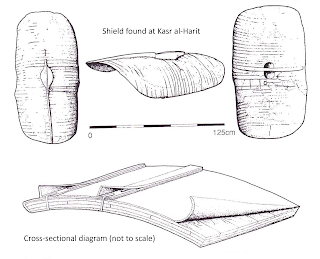Farinata (‘made of flour’), a classic Italian street food, apparently enjoys two provenance myths according to BBC History Magazine [1]. One version from Mediæval times holds that Genoese sailors happened upon this tasty treat when barrels of chickpea flour and oil, which had spilt on their ship’s deck, mixed with seawater and the concoction baked in the sun. However unbelievable the sailors’ yarn might be, the second, and much earlier tale, claims Roman soldiers discovered what would become known as farinata by baking chickpea flour on their shields. This origin story is quoted in the Bradt Travel Guide to Liguria, where farinata is also said to be the region’s ‘oldest dish’ (Whitehouse, 2016, 35). But the source of the legend is not cited, so, can there be any truth to the alleged Roman origin? We think not, for one very simple reason...A novel idea The idea of cooking on or in a shield reminded us of a scene in Lynsey Davis’ Falco novel ‘Venus in Copper’. In the book, the eponymous hero, Marcus Didius Falco had been promised a turbot by the emperor’s son, Titus Caesar. Falco half-jokingly invites Titus to sample the fish after he has had a chance to cook it. Then, when the huge turbot arrives Falco does not have a pot or pan of sufficient size to cook it. He ends up using a bronze round shield as poaching pan. The shield, however, is described as a cheap knockoff tourist souvenir that his brother Festus had previously acquired. Yet it is noteworthy that, although a decorative piece, the ‘shield’ was of bronze. Contrast that with the actual shields carried by Roman soldiers.
The Roman scutum A large, curved plywood shield excavated at Kasr al-Harit in the Egyptian Fayyum was originally identified as belonging to a mercenary serving with the Ptolemaic forces. Its size and shape, however, is remarkably similar to the sculptural representations of shields carried by soldiers on the altar of Domitius Ahenobarbus (below) and the monument of Aemilius Paullus (Bishop & Coulston, 2006, 61).
The Greek historian Polybius, writing in the Hellenistic period of 264 BC - 146 BC, states the Roman infantry shield was convex and measured 1.18 m (4 feet) long by 0.74 m (2½ feet) wide, with a thickness of a palm’s breadth at the rim. He described its construction as follows (Polybius, Historia, VI.23):
By comparison, the shield found in 1900 at Kasr al-Harit (pictured) was 1.28 m long and 0.635 m wide. It was fashioned from three layers of wooden strips, possibly birch wood. The inner vertical strips were overlaid front and back with horizontal layers, to produce a curved plywood shield that was thicker at the centre than at the edges. The nine or ten vertical strips measured between 60 and 100 mm in breadth; the forty horizontal ones were 25 to 50 mm. Both inner and outer surfaces were covered with lamb’s wool felt, but the edges were not reinforced with metal. The shield had a wooden ‘barleycorn’ boss with a vertical rib (spina) attached with iron nails above and below it on the shield face and a horizontal handgrip behind the boss.‘The Roman panoply consists firstly of a shield (scutum), the convex surface of which measures two-and-a-half feet in width and four feet in length, the thickness at the rim being a palm's breadth. It is made of two planks glued together, the outer surface being then covered first with canvas and then with calf-skin. Its upper and lower rims are strengthened by an iron edging which protects it from descending blows and from injury when rested on the ground. It also has an iron boss (umbo) fixed to it which turns aside the most formidable blows of stones, pikes, and heavy missiles in general.’
Over time the large, oval shield of the Republican period was altered to become the iconic square-edged, rectangular version. As shown below, first the curved top and bottom edges were cut square, then the curved sides followed suit. For the next two hundred years or so this convex, rectangular shield remained in use until almost wholly replaced by round shields, which had become much more common by 4th-century AD.
Regardless of the changes to its size and shape, the construction of Roman shields remained consistent. In other words, the shields were made of wood, covered in felt, leather and/or linen - all materials that are clearly flammable. It is therefore unbelievable and highly improbable that Roman soldiers ever cooked chickpea flour, or indeed any of their rations, in or on their shields.
References:
Bishop, M. C. and Coulston, J. C. N., (2006), ‘Roman Military Equipment: from the Punic Wars to the Fall of Rome’ (second edition), p. 61.
Polybius, Historia (‘The Histories’), Book VI.23 (‘The Roman Military System’), Lacus Curtius, Available on-line: https://penelope.uchicago.edu/Thayer/E/Roman/Texts/Polybius/6*.html (accessed February 28th, 2022).
Whitehouse, R., (2016), ‘Liguria’, Bradt Travel Guides, Available on-line: https://books.google.co.uk/books?id=tSSICwAAQBAJ&pg=PA35&redir_esc=y#v=onepage&q&f=false (accessed March 2nd, 2022).
Endnotes:
1. BBC History Magazine, August 2019, ‘History Cookbook: Farinata’, p. 86.







No comments:
Post a Comment